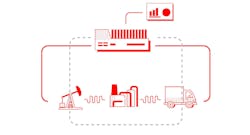Pressure on this summer’s natural gas prices is likely to be neutral compared with last summer, despite expectations for record-setting summer demand, the Natural Gas Supply Association said in its 2019 Summer Outlook assessment. Gas production is expected to set an all-time record, making ample gas supplies available to meet the record demand, NGSA said.
“The picture that has emerged for the upcoming summer is one of remarkable growth in demand that is matched by record-setting production,” said NGSA Senior Vice-Pres. Jenny Fordham. “With more than enough supply to meet demand, we anticipate flat pressure on prices compared to last summer.”
Key demand factors
Combining demand from all major consumers—electric, industrial, residential-commercial, and exports—consulting firm Energy Ventures Analysis (EVA) projects record-high demand of 82.1 bcfd this summer, mainly stemming from growing exports of LNG and healthy demand from industrial businesses.
The greatest demand increase comes from LNG exports to more than 30 countries and pipeline exports to Mexico, Fordham said. LNG summer exports nearly doubled year-over-year but remain only a small part of the overall market for US gas. LNG exports rose as 1.4 bcfd of capacity was added at export terminals since last summer. Additional trains at Corpus Christi, Freeport, Elba Island, and Cameron LNG are scheduled to add an additional 2.3 bcfd of new capacity by summer’s end.
US pipeline exports to Mexico are expected to reach 5.5 bcfd this summer as gas is needed to serve the electric and manufacturing industries. Pipeline projects along the border are helping to meet that demand.
Record-setting industrial demand for gas—almost 3% higher than last summer—is expected, Fordham said, attributable to higher capacity utilization as well as demand from new industrial projects that use gas as a feedstock, such as fertilizer and methanol plants. Fordham said 80 major gas–intensive industrial projects have been or will be completed during 2015-23, representing 3.7 bcfd of added demand for that time period.
The electric industry load is expected to slightly decrease compared with last summer, which was the fourth hottest on record. This summer is projected to be 14% cooler than last summer and therefore less gas is expected to be needed to generate electricity. Fordham said the cooler temperatures will mask underlying growth in structural demand for gas as another 6 Gw of gas-fired generation is online compared with last summer.
Residential and commercial industries are expected to show slightly decreased demand compared with last summer because of the forecast for cooler temperatures.
Fordham said storage will place upward pressure on prices. “Our outlook projects hearty storage injections averaging about 85 bcf/week this summer. These are sizeable injections, but not unprecedented, since industry refilled storage at an average rate of 89 bcf/week in 2014.”
Key supply factors
NGSA’s outlook forecasts a summer of continued record production. “Production is thriving from numerous plays, deepwater projects in the Gulf of Mexico, and new takeaway capacity in the Permian to soon bring long-awaited relief to the region,” Fordham said.
NGSA’s analysis of individual supply and demand factors showed:
• Weather—Anticipated 14% cooler than last summer and 3% warmer than the 30-year average. Downward pressure.
• Economy—Steady growth in gross domestic product expected. Neutral-flat pressure.
• Overall demand—Customer demand projected to reach 82 bcfd. Major growth of 44% expected in the export industry, with LNG exports reaching 6 bcfd and pipeline exports to Mexico reaching 5.5 bcfd. Electric, residential, and commercial industry demand are expected to decrease slightly compared with last summer because of a cooler summer. Industrial demand is projected to increase because of higher capacity utilization and new projects. Neutral pressure.
• Storage—High weekly gas injections of 85 bcf/week predicted compared with last summer. Upward pressure.
• Supply—Estimated summer production of 89 bcfd because of heightened production and new infrastructure, projected to provide more than enough supply. Downward pressure.
NGSA used data from EVA and the US Energy Information Administration for its demand and supply projections and IHS Markit Macroeconomic Advisers for its economic projections. NGSA’s analysis is based on publicly reported data; the association does not project actual cost figures for wholesale or retail markets.

